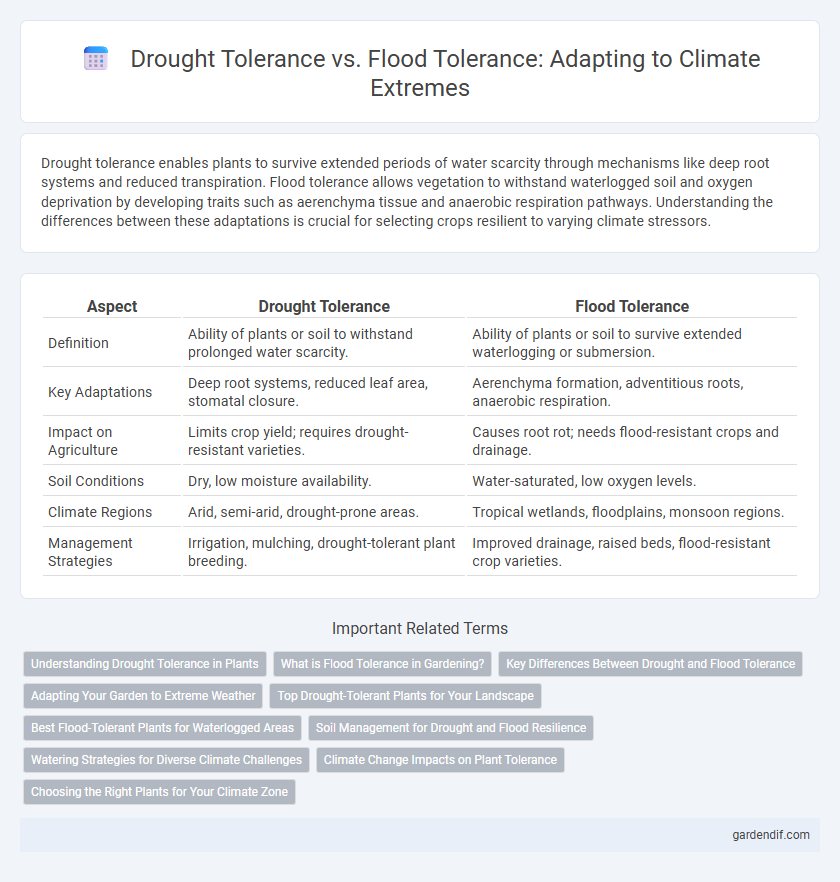
Drought tolerance vs Flood tolerance Illustration
Drought tolerance enables plants to survive extended periods of water scarcity through mechanisms like deep root systems and reduced transpiration. Flood tolerance allows vegetation to withstand waterlogged soil and oxygen deprivation by developing traits such as aerenchyma tissue and anaerobic respiration pathways. Understanding the differences between these adaptations is crucial for selecting crops resilient to varying climate stressors.
Table of Comparison
| Aspect | Drought Tolerance | Flood Tolerance |
|---|---|---|
| Definition | Ability of plants or soil to withstand prolonged water scarcity. | Ability of plants or soil to survive extended waterlogging or submersion. |
| Key Adaptations | Deep root systems, reduced leaf area, stomatal closure. | Aerenchyma formation, adventitious roots, anaerobic respiration. |
| Impact on Agriculture | Limits crop yield; requires drought-resistant varieties. | Causes root rot; needs flood-resistant crops and drainage. |
| Soil Conditions | Dry, low moisture availability. | Water-saturated, low oxygen levels. |
| Climate Regions | Arid, semi-arid, drought-prone areas. | Tropical wetlands, floodplains, monsoon regions. |
| Management Strategies | Irrigation, mulching, drought-tolerant plant breeding. | Improved drainage, raised beds, flood-resistant crop varieties. |
Understanding Drought Tolerance in Plants
Drought tolerance in plants involves complex physiological and biochemical adaptations such as deep root systems, stomatal regulation, and osmotic adjustment to maintain water balance under prolonged dry conditions. This trait enables plants to survive and grow despite limited soil moisture by minimizing water loss and efficiently using available water resources. Understanding these mechanisms is crucial for developing crop varieties resilient to water scarcity amid increasing climate variability.
What is Flood Tolerance in Gardening?
Flood tolerance in gardening refers to a plant's ability to survive and thrive in waterlogged soil or standing water conditions caused by excessive rainfall or poor drainage. Plants with high flood tolerance possess adaptations such as aerenchyma tissue for oxygen transport, shallow root systems, and mechanisms to prevent root rot. Selecting flood-tolerant species is essential for gardeners in regions prone to heavy precipitation or seasonal flooding to maintain healthy landscapes and prevent crop loss.
Key Differences Between Drought and Flood Tolerance
Drought tolerance refers to a plant or organism's ability to survive and maintain functionality under limited water availability by employing mechanisms such as deep root systems, reduced transpiration, and osmotic adjustment. Flood tolerance involves adapting to excessive water or oxygen-deprived conditions through traits like aerenchyma formation, adventitious rooting, and anaerobic respiration. Key differences include the contrasting physiological adaptations to water scarcity versus water excess and the activation of fundamentally different metabolic pathways to endure hydrological stress.
Adapting Your Garden to Extreme Weather
Drought tolerance in plants involves mechanisms like deep root systems and water-efficient stomata to conserve moisture during prolonged dry periods. Flood tolerance, on the other hand, requires adaptations such as aerenchyma tissue for oxygen transport and the ability to survive waterlogged soils. Selecting and planting species with either drought or flood tolerance enhances garden resilience against extreme weather caused by climate change.
Top Drought-Tolerant Plants for Your Landscape
Top drought-tolerant plants such as lavender, succulents, and agave thrive in arid conditions by efficiently storing water and minimizing transpiration. These plants improve landscape resilience by reducing irrigation needs and maintaining greenery during extended dry periods. Incorporating native drought-resistant species like yucca and sagebrush further enhances sustainable landscaping in regions prone to water scarcity.
Best Flood-Tolerant Plants for Waterlogged Areas
Flood-tolerant plants such as rice (Oryza sativa), cattails (Typha spp.), and water lilies (Nymphaea spp.) thrive in waterlogged environments by adapting their root systems to low oxygen levels. These species exhibit traits like aerenchyma formation and adventitious root growth, enabling survival under prolonged flooding conditions. Selecting plants with proven flood resilience enhances ecosystem stability and mitigates soil erosion in flood-prone regions.
Soil Management for Drought and Flood Resilience
Effective soil management for drought resilience emphasizes enhancing soil organic matter to improve moisture retention and reduce evaporation, enabling crops to withstand prolonged dry periods. Conversely, flood tolerance in soil management focuses on improving soil structure and drainage systems to prevent waterlogging and promote anaerobic conditions conducive to root survival. Implementing techniques such as cover cropping, mulching, and controlled drainage optimizes soil health and boosts tolerance against both extreme drought and excess water scenarios.
Watering Strategies for Diverse Climate Challenges
Drought tolerance requires deep-rooted plants and infrequent, deep watering to maximize moisture absorption and reduce water loss, while flood tolerance demands well-draining soil and controlled irrigation to prevent root rot and oxygen deprivation. Watering strategies must be tailored to plant species and local climate conditions, balancing soil moisture levels to enhance survival and growth under extreme dryness or excessive water. Employing mulching and drip irrigation optimizes water use efficiency, supporting resilience in both drought-prone and flood-affected environments.
Climate Change Impacts on Plant Tolerance
Drought tolerance and flood tolerance are critical adaptive traits influencing plant survival amid climate change-induced extreme weather patterns. Increased frequency of prolonged droughts demands enhanced water-use efficiency and deep root systems, while more intense flooding requires traits like aerenchyma formation and anaerobic respiration capabilities. Understanding these contrasting tolerance mechanisms is essential for developing resilient crop varieties and conserving ecosystems under shifting climate regimes.
Choosing the Right Plants for Your Climate Zone
Selecting plants with drought tolerance enhances survival in arid climate zones by reducing water needs and preventing soil erosion. Flood-tolerant species thrive in regions with heavy rainfall or poor drainage, absorbing excess water and minimizing root rot. Understanding the specific climate zone's precipitation patterns ensures the right plant choice for sustainable landscaping and improved ecosystem resilience.
Drought tolerance vs Flood tolerance Infographic

 gardendif.com
gardendif.com